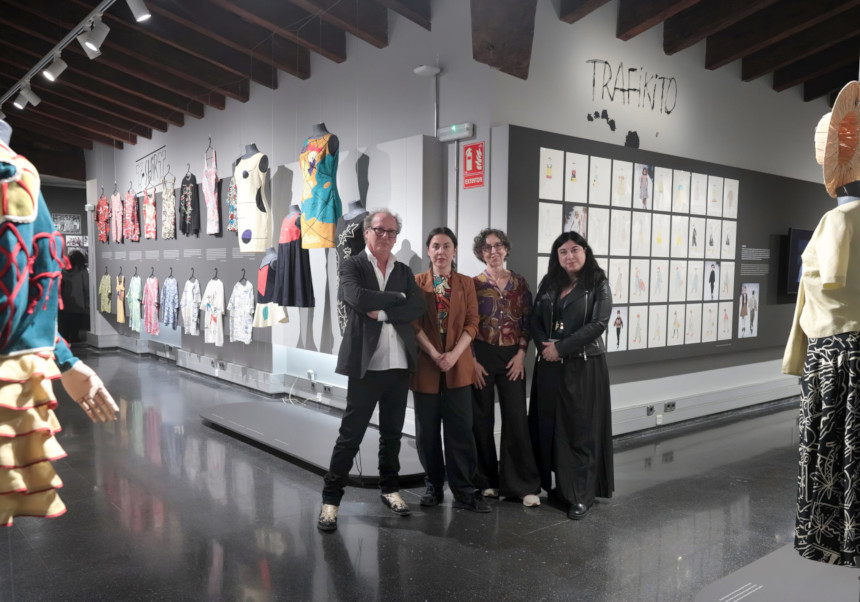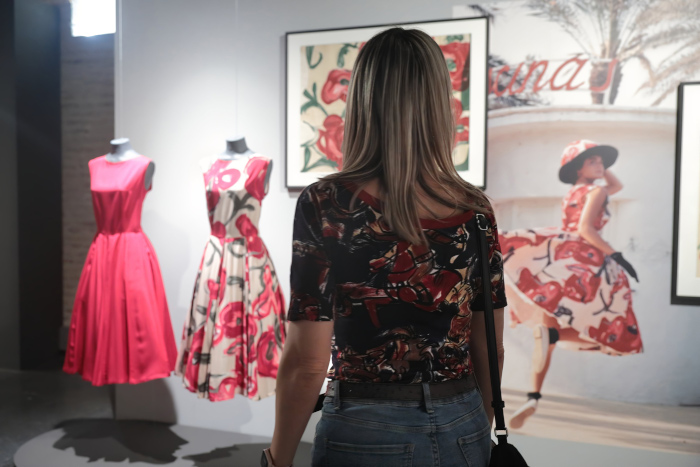
La Nau Cultural Centre has presented this morning the exhibition ‘Tráfico de modas (1980-1992). Arrebato, juego y familia’, organised by the Universitat de València, through the Office of the Vice-Principal for Culture and Society, with the collaboration of the Valencian Archive of Design
The exhibition has been presented this morning in a press conference that has counted with the intervention of Ester Alba, Vice-Principal for Culture and Society of the UV and the curatorial team of the exhibition: Esther González Gea, Pedrín Errando Mariscal and María José Villalonga. The designer Javier Mariscal will assist to the official inauguration today at 8pm.
After the dictatorship in Spain that was on until the end of the 70s, the 80s was characteristic for its effervescence and liberalization, an emergence of all that was repressed. In such setting, some young Valencians wanting to leave their middle-class home, have some fun and, above all, dress with a yet to be invented fashion, started the project Tráfico de Modas.
The Vice-Principal Ester Alba has underlined the importance of this brand that emerged “in the Valencian cultural and artistic ecosystem, through a family project, led by young idealists, that lived a frenetic period, in which utopias were built”. Through this exhibition, that can be visited in La Nau Cultural Centre and, as they have announced, that will later go all over the Valencian territory, a part from the meticulous catalogue “new generations will get to know the work of one of the very first Valencian business based on design culture”.
The name of this singular brand, has the curator team explained, responds to a play on words that challenged the stable processes in benefit of a more ludic creating way. Some of the Errando Mariscal siblings -Pedrín being the head as the designer, Santi, Jorge and Ada-, along with María José Villalonga, began a creative project, from a flat in Calle de las Comedias, right next to La Nau, that led them to occupying a space inside of the national fashion. Shortly after, Carlos, Tono, Nacho, and Amparo came along. And collaborating with them from the beginning on the design of prints and the graphic, Javier Mariscal.
During the press conference, the curator team has reminded the international success of the brand. The European press made echo of that stamp. The first presentation of their collections was in the Salón Gaudí of Barcelona in 1984. From the following year onwards, they modelled in the Pasarela Cibeles of Madrid until Tráfico de Modas closed in 1992. They were also invited to participate in the Salón Neomoda of Milan (1986/1987), in the presentations of Moda de España in Dusseldorf (1989/1990), and a year before closing, in 1991, they had signed a contract with a big Japanese textile company, they had their own four shops in Valencia, Barcelona, Madrid and Valladolid and they were present in the best multi-brand shops of Spain.
Pedrín Errando Mariscal has reminded that “Tráfico de Modas started with a hasty success and ended of an early death in the 90s”. With the consolidation of globalised capitalism as an hegemonic model, the growing formula of economic fast fashion won ground and affected numerous textile companies, so holding quality production in national territory was more and more complicated. “Now, through this exhibition, for which special thanks to María José Villalonga, has been done an archaeology work to recover everything from an analogic culture, we are a little bit more conscious of being more important that we thought to be in that period”.
This exhibition has the purpose of narrating the project of Tráfico de Modas as a testimony of one of the most effervescent decades of the last 50 years through the vital and creative trajectory of this young group. Located in the Beam Hall of Centre Cultural La Nau until the next 12 October, this circular space helps structure the narration chronogically. The main proof of importance of the family clan, the most old-fashioned beginnings, the first parades in Cibeles, the transgressive graphic of their catalogues, etc.

The pathway continues going across the most iconic collections of the brand and the most characteristic designs: art allusions, game of words, timeless pieces of clothes, etc. They also exhibit the exuberant creation of prints that Mariscal created for the brand, the drawings and aquarelles of Pedrín, photographies and videos from the parade, and pieces of clothes and most characteristic accessories. And, to finish, the forced end of Tráfico de Modas that is explained through the testimonies of their main characters.
The walls of the exhibition feature the opinions of their makers. Pedrín Errando Mariscal describes the story of Tráfico de Modas as “frenetic because situations were always about to beat us. And despite this, the reason for closing did nothing to do with our work. It had to do with a deep crisis in the textile industry caused by the irruption of fast fashion which relocated production, they filled the distribution and the consumer changed its habits to disposable. Today, distribution chains promoting cheap hyperconsumption have take control of almost all sectors and the world has come accross a really important problem of sustainability”.
Javier Mariscal makes reference to its unexpected beginning: “Tráfico de Modas was born without wanting it. It is born from kind of jumping from a cliff. They didn’t know if at the bottom there was water, if they would touch the ground, if it would be dry and they would hit the ground. But thank to God there was water and they quickly learnt how to swim. I was excited, mostly from seeing that everyone got going so fast. They had a lot of energy. And they were capable of surprising me each month. I was hallucinating. I really don’t care how Tráfico is remembered. I always ride my Vespa and never loo through the side mirror”.
For her part, María José Villalonga underlines that she will never forget those years: “For me it was a marvellous work and a cool way of living, so much that we invented it until it ended, and for me, it wasn’t that bad. I wouldn’t have changed anything. When we closed Tráfico, we gathered up everything inside a van, we put it away in a warehouse, and this way we were able to do a beautiful exhibition. I like to have a beginning and an end for everything”.
Lastly, the researcher and teacher Esther González Gea that would also commission this exhibition, makes reference to the capacity of fashion to generate meanings: “Pieces of clothes tell stories and give messages that get into a dialogue with the context surrounding them. The creations of Tráfico de Modas were capable of fitting into their time, reflecting the sociocultural context to which they were part of, narrate their own vision of that particular moment, embrace their aesthetic tastes and remain alive”.
Through this exhibitions the Universitat de València reinforces the exhibitions line promoted by the Valencian Archive of Design, a body from the UV and the EASD of Valencia created to conserve all design materials and that was born precisely thanks to the donations to the cause. After this exhibition, a part from the designs of this iconic Valencian brand, they will also become part of this archive’s collection, since their responsibles have generously donated them.
The exhibition goes along with the meticulous catalogue that contains texts from the co-commissioner, Esther González Gea, of Cristina Pérez, of Carles Gámez, and for which is also coordinator of this volume, C. Rafael Martínez-Martínez. It will be included at the same time a great number of pictures coming from the Tráfico de Modas archive. We are talking about photographs from parades, from the members of the brand under the charge of photographers such as Enrique Carrazoni or Ouka Leele, of the clothes or mere press cuts from the period. The graphic design, really taken care of, was under the charge of the designer Mati Martí. The edition is formed, as is usual, by 500 printed copies.
Links:




